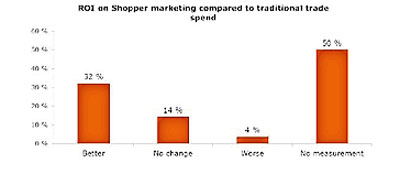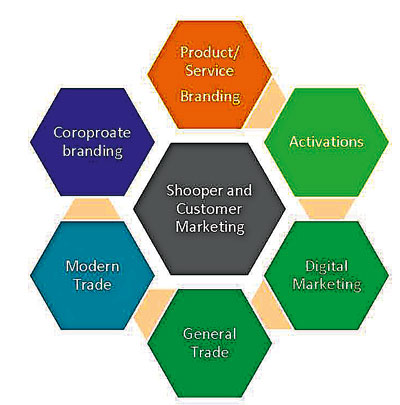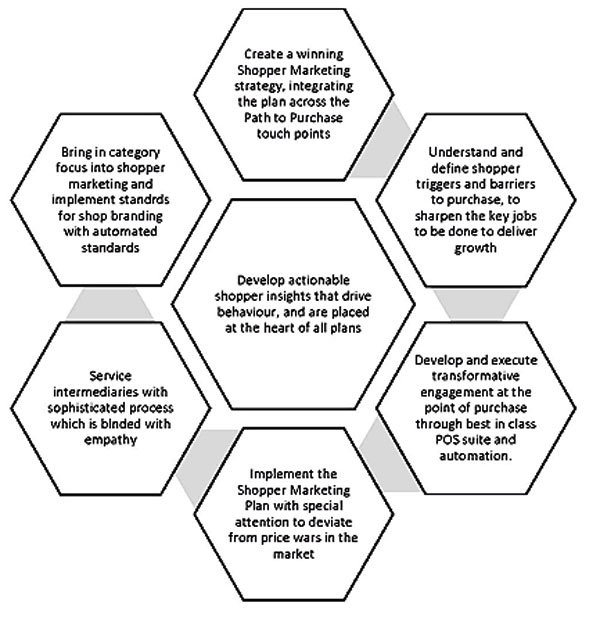Shopper and Customer Marketing
 What is shopper/customer marketing?
What is shopper/customer marketing?
Everything in marketing and branding are directed towards identification or anticipation of what consumers would need and how effective they would be in meeting expectations. In a market like Sri Lanka where the maximum potential for growth is limited to 22 million people and 5.4 million households, it’s obvious that, the impact sales can make is significant in reaching organisational goals and targets. In conventional marketing; there was an eternal tug-a-war between sales and brands and it’s inevitable given the fact that brands are mostly driven by insights of consumers and sales are mostly driven by the insights of the dealers, customers, distributors, retailers etc. Therefore, if we are to understand the functionality or the role of Customer Marketing, it’s of paramount importance to see where it sits in the marketing function.
 Hence, it’s safe to define shopper and customer marketing as: “The systematic creation and application of elements of the marketing mix to affect positive change in shopper behaviour in order to drive consumption of a brand and servicing and recognising intermediaries as partners of the business for sustainable growth”.
Hence, it’s safe to define shopper and customer marketing as: “The systematic creation and application of elements of the marketing mix to affect positive change in shopper behaviour in order to drive consumption of a brand and servicing and recognising intermediaries as partners of the business for sustainable growth”.
Significance of Shopper Marketing
Shopper marketing is becoming increasingly important for consumer goods companies in Asia. 82% of companies report that shopper marketing will become more important in the future. Many businesses in Asia plan to invest significantly in shopper marketing and believe this will increase: some 50% intend to invest more money in the future, and 36% say that shopper marketing already accounts for more than 10% of total marketing spend. 64% of respondents say that there is an annual budget set aside for shopper marketing activities. Beyond the lack of business process, it appears that talent shortages are the biggest hindrance to the successful adoption of shopper marketing in Asia. Only 4% of respondents scored their company’s shopper marketing competence as “advanced”: 96% scored as “developing” or lower. Talent shortages (68%) and lack of training (50%) are cited as the key reasons behind this.
Businesses should adopt a Total Marketing approach that incorporates shopper marketing into current commercial practices. This should leverage shopper insight within a clear step by step process to developing strategies and investment plans. Businesses should seek to fast-track shopper marketing by developing people with existing marketing competencies into total marketers of the future. Respondents of surveys carried out by Nielson predict that shopper marketing will become more important for companies they work for in Asia. No one felt that the discipline would become less important; 12% of managers surveyed believe that shopper marketing’s importance to their companies would remain unchanged.
An approach to effective shopper and customer marketing
It’s crucial to look at the overall function of shopper and customer marketing as a hub among all the other functions as depicted above. There should be two categories of factors in the possession of those who lead the shopper and customer marketing function.
Combining all of them into one framework would make more sense as it will encapsulate all functionalities in a more meaningful manner.
Shopper and Customer Marketing in the Sri Lankan context
First: It’s pivotal to understand the importance of having authentic shopper insights of the Sri Lankan market in this aspect as we as a country and profession tend to rely on insights gathered in India and various other countries due to the unavailability of seasoned professionals to carry out such studies and also due to budget constraints.
Second: it’s important to create value to the shopper at this point of time considering the pandemic situation. Value creation could be done in two ways; one is to arrange door-step deliveries as majority have travel restrictions. Family packs, single packs, Senior citizen packs, economy packs, bathroom packs etc could be introduced as bundled offers during this season as majority look for offers irrespective of the social standards they maintain and the social class they belong to. It’s also important to understand that out of 40-50% margins that are made in the FMCG sector, at least 30% is spent on advertising. The time has come to make more offers in the short-run for the benefit of consumers. However, brand building has to continue as it’s the only thing which can give long term benefits for the organisation.
 Third: Research customers, and intermediaries to get closer to their hearts and identifying them as partners of the business than outsiders. This can take the company a longer way. Service them with respect, follow up on deliveries and making them feel important and recognising them along the way is vital for success.
Third: Research customers, and intermediaries to get closer to their hearts and identifying them as partners of the business than outsiders. This can take the company a longer way. Service them with respect, follow up on deliveries and making them feel important and recognising them along the way is vital for success.
Fourth: If you are a local company, highlighting the fact that you are a truly Sri Lankan company and making intermediaries feel proud of their service to the nation is also a true value creator.
Fifth: In addition to product branding, building a strong and resilient corporate umbrella brand is something which can make everyone in the process proud, including, employees, shoppers, customers, consumers, suppliers, and other interested parties.

Customer Marketing sits in the middle of all the other functions that needs to be carefully handled for excellence in delivery of purpose driven marketing
The above factors combined with the desire to lead in conjunction with Brand Building (consumer marketing teams) and Key Account Managers (KAM) to develop tailored shopper marketing plans for key customers would be essential for success. Managing collaborative creative agency relationships, through inspirational briefs, holding them accountable for deliverables and within budget is also an important KPI of this role. Work closely with Retail Execution and KAMs to ensure all in-store activations land successfully on time in full as planned can complement all the other actions. Ensuring any Sales Management plans have a positive return on investment and deliver tangible results with an uplift in sales/penetration is expected under the same role.
Conclusion:
75% of the people who responded to Nielson’s survey mentioned that they expect to see a sales lift and brand share increase as results of any shopper and customer marketing activity planed/ executed. 64% mentioned that they would expect a volume growth and 50% stated that they want categories to grow. All in all, proper planning and execution of Shopper and Marketing functions as a strategy with the right team would surely bring results beyond expectation if executed right which requires, knowledge in both sales and branding with excellent leadership, communication and envisioning skills.


Source: Neilson online Survey among 63 senior executives: Base (n=63) What gets measured gets done. The same applies to shopper marketing as well. Not having a way of measuring the outcome would be as bad as not having the function at all.


